Results 1 to 2 of 2
Thread: Another oddity: William Dadley
-
03-30-2018, 03:34 AM #1
 Another oddity: William Dadley
Another oddity: William Dadley
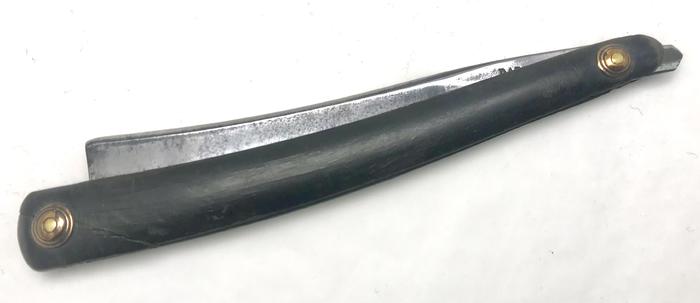
If youíre attuned to the Old Sheffield aesthetic, the first thing youíre likely to notice is the tail. The second thing is the slightly unusual scale shape.
Here it is compared to an 1810ish Wilson & Co.
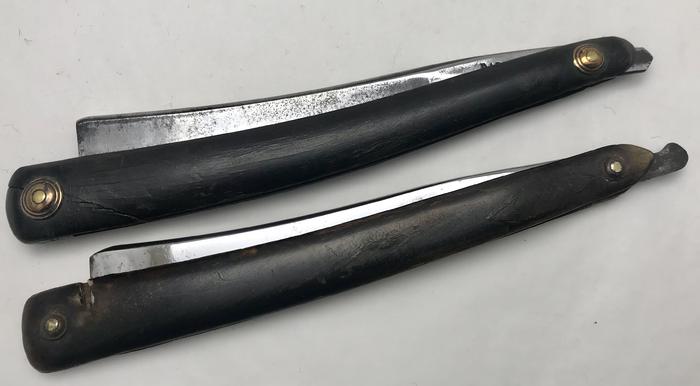
You can see that the scales have a very slight downward curve as they bend toward the pivot, sort of like gunstock scales.
So letís open it up and see what weíve got here.
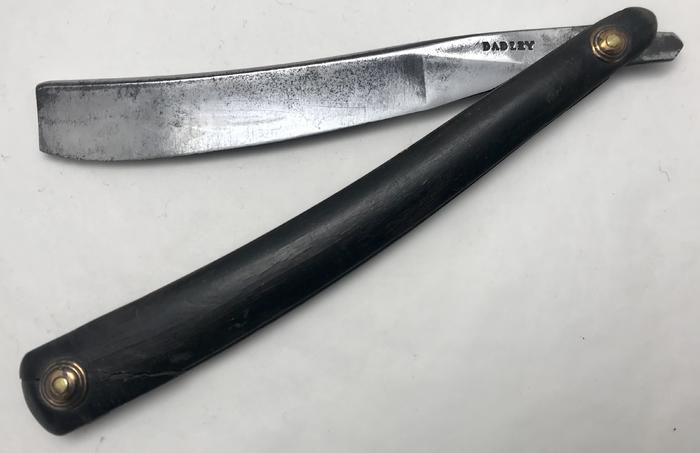
Thatís not a very 1810ish blade style. I know it superficially resembles the 1700ís type razor (and it might be! Iíll get into that in a bit), but what it most closely resembles is this pattern which was made primarily by Wade & Butcher and Fred Fenney, as you can see.
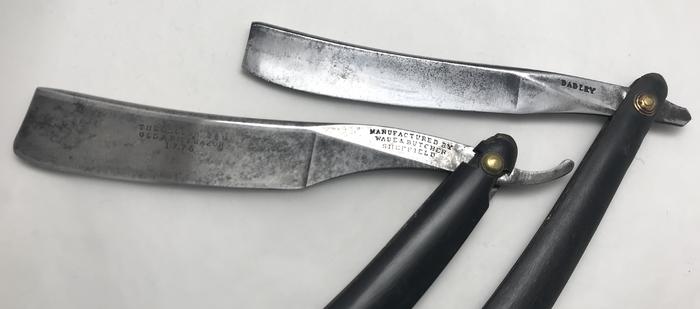
Itís not a perfect match (they really, really definitely werenít made by the same people). The earliest reference Iíve seen to the Wade & Butcher version of these razors is 1851. Fred Fenney died in 1852, so thatís a reasonable guess for the early end of its production. (Fenneyís version was labeled ĎAdamantine Edgeí).
That date is right out for the Dadley razor though. He died in 1846.
Before getting into that, there are some more unusual features.
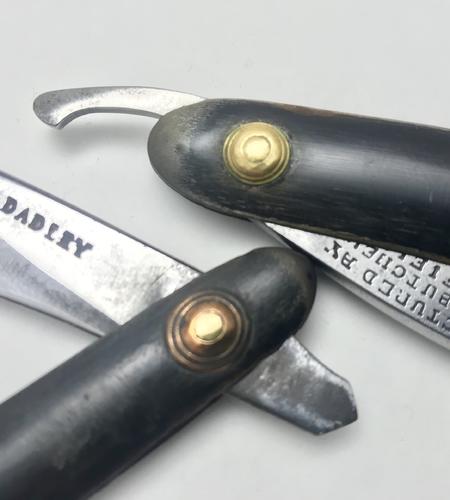
The washers are a different alloy of brass from the standard Sheffield. You can see it has a higher percentage of copper.
Thatís not all thatís different about them.
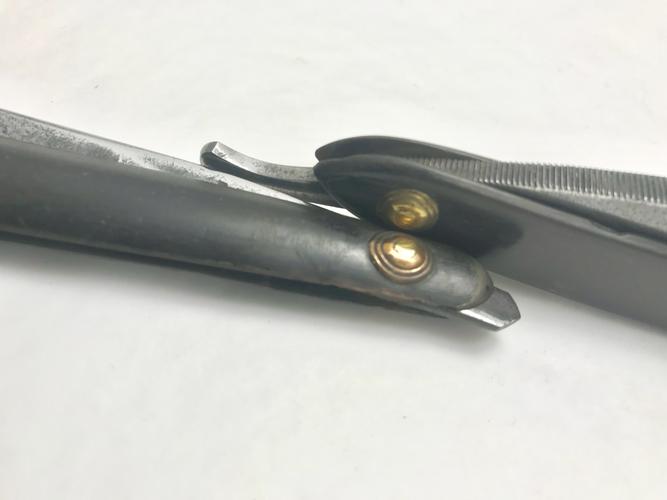
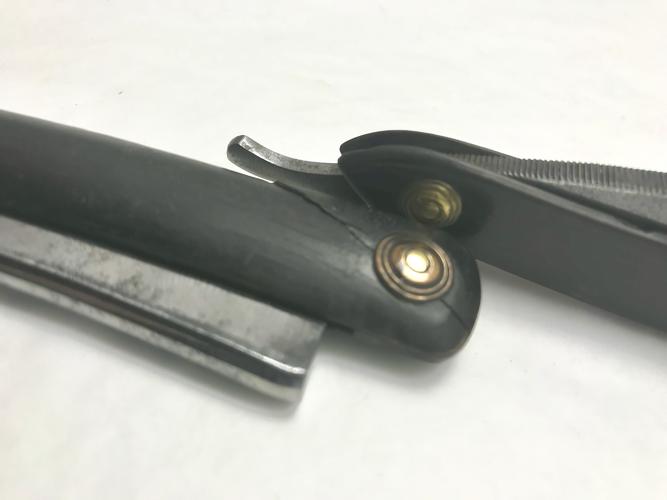
The two sets of washers are different sizes. In those two pictures, you can see the pivot washer is just about a perfect size-match for the Greaves, but the point-end is a little bit bigger.
Thatís a feature more commonly seen on older (pre-1800) Sheffield and French razors.
By this point youíve probably guessed where Iím going with this.
It was not made in Sheffield.
Some of you ó the knife folks ó may have had bells go off at that name, too. Iíll get into all that in the next post.-Zak Jarvis. Writer. Artist. Bon vivant.
-
The Following 4 Users Say Thank You to Voidmonster For This Useful Post:
bartds (03-30-2018), Geezer (03-30-2018), MisterClean (04-02-2018), outback (04-01-2018)
-
03-30-2018, 04:07 AM #2

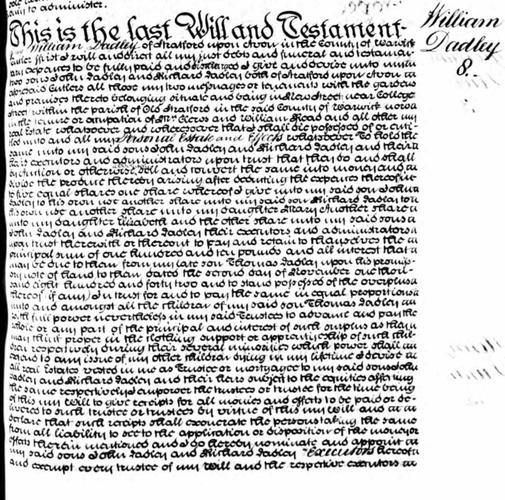
That's the first page of William Dadley's will. (It takes some effort to decipher if you're not steeped in handwritten documents of the era).
William Dadley was a cutler in Stratford-upon-Avon.
He was born in 1774 and died in 1846.
In 1841 when the first census was taken, he was listed as retired while his son Thomas still lived with him and stated his occupation as Cutler.
The 1822 Pigot's directory lists him as the sole cutler in the small town of Stratford-upon-Avon.
That's about it for business records. Well, other than the dissolution of the business in 1848.
Earlier I mentioned that knife folks might perk their ears up at this name. That's because it's the name of a type of knife. The Dadley knife (kind of like the Bowie knife). Dadley knives, apparently, are an iconic early American bit of frontier cutlery that's mostly associated with a particular firm in the states. There are nebulous references to a Sheffield cutler who may have invented it, but the form is considered American. Without seeing the stamps on the earliest extant Dadley knives, I really can't say for sure, but I would be willing to bet some money they were made by William Dadley in Stratford-upon-Avon, not Sheffield.
I'm confident that Dadley was making his own goods rather than paying a Sheffield cutler to stamp his name on them. There are enough features that are just slightly off that I really don't think it came off a Sheffield stiddy. (Neil would kick me for this).
When was it made? I'd guess 1820's, just because that's when he had enough interest in having his business advertised in Pigot's, but it could date to the late 1700's or the early 1840's. I don't have any real way to evaluate it!
As for Stratford-upon-Avon, it's a quiet little town a bit south east of Birmingham (which is likely where Dadley learned his trade). There was another William associated with it you're more likely to have heard of. Look it up, you'll see. Dadley's shop was just a few blocks from that other, more famous William's putative digs. I believe it is currently a tattoo parlor (and a pretty good one at that!)-Zak Jarvis. Writer. Artist. Bon vivant.
-
The Following 17 Users Say Thank You to Voidmonster For This Useful Post:
782sirbrian (03-30-2018), bartds (03-30-2018), BobH (03-30-2018), Dieseld (03-30-2018), Gasman (03-30-2018), Geezer (03-30-2018), Hanlon (03-30-2018), karlej (03-31-2018), kjbarth (04-01-2018), markbignosekelly (03-30-2018), MisterClean (04-02-2018), Oldnick (03-30-2018), outback (04-01-2018), RezDog (03-30-2018), ScienceGuy (03-30-2018), sharptonn (03-30-2018), tintin (03-30-2018)


 20Likes
20Likes LinkBack URL
LinkBack URL About LinkBacks
About LinkBacks







 Reply With Quote
Reply With Quote
